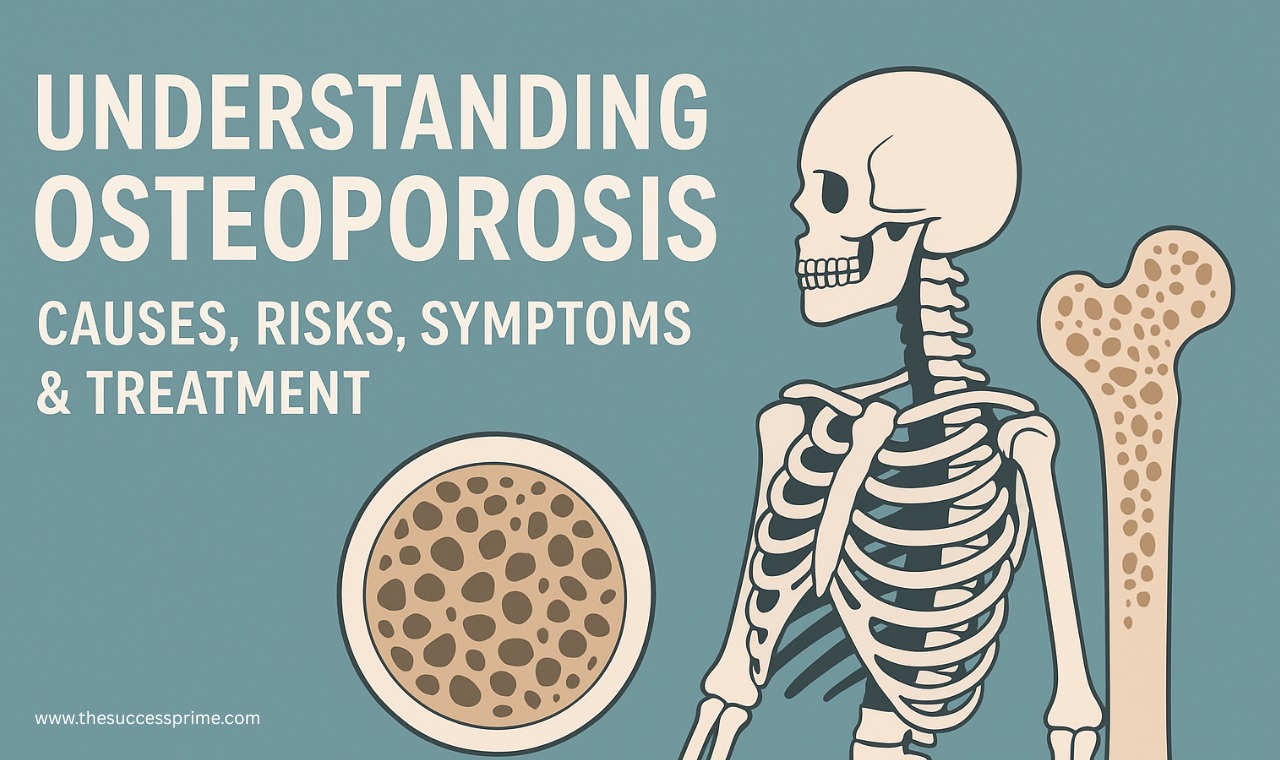The Silent Bone Disease: Early Signs, Risks & Treatments for Osteoporosis
A decrease in bone mass and degeneration of bone structure are the hallmarks of osteoporosis, a degenerative bone disease. Because of the reduced bone strength caused by this illness, even minor stress can cause the bones to break.
Bone mineral density (BMD) and total bone mass loss over time are the main causes of the condition. It could also result from structural changes that jeopardize the mechanical integrity of the internal structure of the bone.
Osteoporosis is essentially the result of an imbalance between bone resorption, which is the process by which old bone is broken down and replaced by new tissue, and bone production. Bones become porous, lose density, and are more prone to fracture when this equilibrium is upset.
Because osteoporosis typically has no symptoms, it is referred to be a “silent” illness. Until you break a bone, you might not even be aware that you have the illness. Any bone might experience this, but the hip, wrist, and vertebrae in the spine are the most frequently affected.
Understanding Osteoporosis: Causes, Risks, Symptoms & Treatment
Osteoporosis is a condition that weakens your bones, making them fragile and more likely to break. It often develops slowly over time and is sometimes called a “silent disease” because most people don’t realize they have it until a fracture occurs.
Let’s understand what causes osteoporosis, who is at risk, and how you can manage or prevent it.
What Causes Osteoporosis?
Because your bones are living tissue, they continuously regenerate new bone by breaking down old bone.
When your body breaks down more bone than it can repair, osteoporosis develops. Consequently, the interior structure of bones becomes weaker and more porous, and bone mass declines.
As you age, this process occurs naturally, but some risk factors might hasten it or increase your vulnerability.
Who Is More Likely to Develop Osteoporosis?
Osteoporosis can strike everyone, although certain people are more susceptible than others because of biological and lifestyle factors:
- Sex
- Because testosterone, a hormone that helps preserve bone structure, decreases after menopause, women are more vulnerable to osteoporosis.
- Age
- The risk increases as you get older, especially after 50.
- Body Type
- People who are thin or have small, light bones are more likely to lose bone mass quickly.
- Race & Ethnicity
- White and Asian women face the highest risk.
- African American and Mexican American women generally have stronger bone density.
- Among men, white men are more likely to develop osteoporosis than others.
- Family History
- If your parents had osteoporosis or suffered a hip fracture, your chances of developing it increase.
- Hormonal Changes
- Low levels of hormones such as estrogen (in women) or testosterone (in men) can weaken bones.
- Diet & Nutrition
- A diet low in calcium, vitamin D, or protein can reduce bone strength.
- Long-Term Medications
Some medicines can affect bone health, such as:
- Corticosteroids (used for asthma or arthritis)
- Proton pump inhibitors (for acid reflux)
- Certain epilepsy drugs
- Medical Conditions
Diseases like rheumatoid arthritis, thyroid disorders, digestive issues, HIV, anorexia nervosa, and certain cancers can contribute to bone loss.
- Lifestyle Factors
- Smoking
- Heavy alcohol use
- Physical inactivity or being bedridden for long periods
All these can reduce bone density and increase the risk of fractures.
What Are the Symptoms of Osteoporosis?
Osteoporosis usually doesn’t cause pain or symptoms until a bone breaks.
Common signs that may appear later include:
- Sudden back pain
- Loss of height over time
- A stooped or curved posture
- Bones that break easily from minor falls or bumps
How Is Osteoporosis Diagnosed?
Doctors often diagnose osteoporosis during a routine bone health screening, especially for women over 65 or postmenopausal women with risk factors.
Your healthcare provider may:
- Ask about your medical history and past fractures
- Check for posture changes, balance issues, or height loss
- Order a bone density scan (DEXA scan) to measure bone strength
- Perform a fracture risk assessment to estimate your chances of breaking a bone in the next 10 years
Treatment Options for Osteoporosis
The main goals of treatment are to slow bone loss, strengthen bones, and prevent fractures.
Depending on your condition, your doctor may recommend:
- A Healthy Diet
- Eat foods rich in calcium (milk, yogurt, leafy greens) and vitamin D (fish, eggs, sunlight exposure).
- Include protein to support bone repair and muscle strength.
- Lifestyle Changes
- Quit smoking and limit alcohol use.
- Stay active — include weight-bearing exercises like walking, light jogging, or dancing, along with strength training and balance exercises.
- Fall Prevention
- Keep your home clutter-free and well-lit.
- Use non-slip mats and supportive footwear to avoid falls.
- Medications
Doctors may prescribe:
- Anti-resorptive drugs – slow down bone breakdown.
- Anabolic agents – help build new bone.
Always follow your doctor’s guidance for dosage and duration.
- Activities to Avoid
If you have osteoporosis, avoid movements that strain your spine, such as:
- Twisting your back (like swinging a golf club)
- Bending forward from the waist (sit-ups, toe touches)
Can Osteoporosis Be Prevented?
Yes — it’s never too early or too late to protect your bones.
You can lower your risk by:
- Eating a calcium- and vitamin D-rich diet
- Getting regular physical activity
- Avoiding smoking and excessive alcohol
- Maintaining a healthy weight
- Discussing bone health screening with your doctor if you’re over 50 or postmenopausal
Osteoporosis Treatment: Step-by-Step for Patients
- Visit your doctor – Talk to your doctor if you have weak bones or back pain.
- Get a bone test – A bone density (DXA) scan shows how strong your bones are.
- Take calcium – Eat calcium-rich foods like milk, cheese, or take doctor-advised supplements.
- Add vitamin D – Spend some time in sunlight or take vitamin D tablets.
- Start medicine – Your doctor may give medicines to stop bone loss or help rebuild bones.
- Exercise daily – Walk, climb stairs, or do light weights to keep bones strong.
- Do balance training – Gentle exercises like yoga or tai chi help prevent falls.
- Quit smoking & avoid alcohol – Both can make bones weaker.
- Make your home safe – Use anti-slip mats, good lighting, and avoid clutter to prevent falls.
- Go for regular check-ups – Visit your doctor every few months and repeat bone tests when needed.
Final Thoughts
Osteoporosis doesn’t have to take away your strength or confidence. With the right mix of nutrition, exercise, and medical care, you can maintain healthy bones and live an active, fulfilling life.
Early awareness and preventive care are your best defense — take steps today to protect your bones for tomorrow.
Click Here: Everything About Apples – From Orchards to Apple Pie & Beyond












Leave a Reply